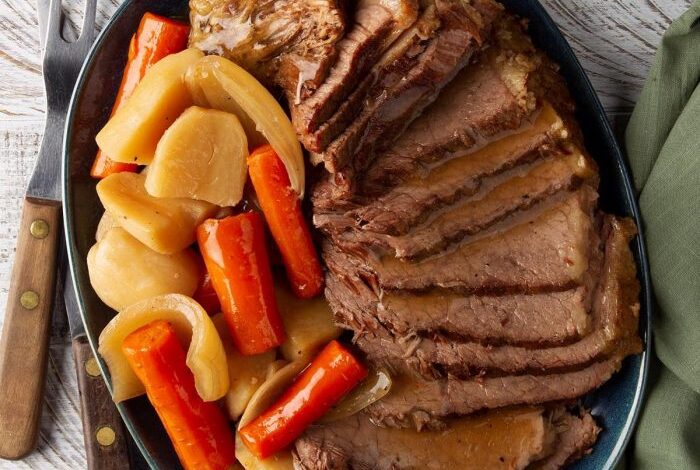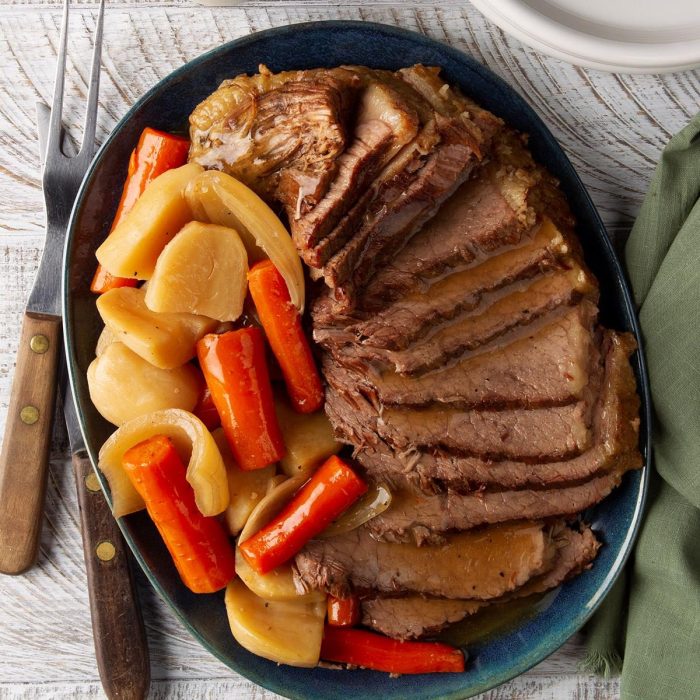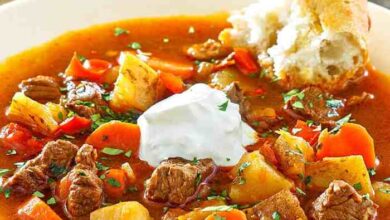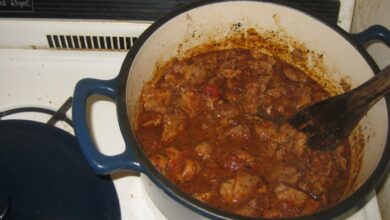
Tender Slow Cooked Pork Roast: A Culinary Journey
Tender slow cooked pork roast is a dish that embodies the essence of comfort food. It’s a symphony of flavors and textures that transcends mere sustenance, becoming a culinary experience that brings people together. The history of slow cooking is deeply intertwined with human ingenuity, dating back to ancient times when people discovered the magic of transforming tough cuts of meat into tender, succulent meals over low heat.
The slow, gentle heat breaks down collagen, rendering the meat incredibly soft and juicy, while the long cooking time allows the flavors to meld and deepen, creating a masterpiece of taste.
I remember one particular Sunday afternoon when I decided to try my hand at slow-cooking a pork shoulder. The aroma that filled the house was intoxicating, a blend of savory spices and sweet caramelization. As the hours passed, the anticipation grew, and finally, the moment arrived.
I carefully carved the roast, revealing layers of succulent, fall-off-the-bone meat. It was a revelation – a testament to the transformative power of slow cooking. The tender, flavorful pork was a true triumph, and it became a family favorite that we continue to enjoy to this day.
The Allure of Tender Slow-Cooked Pork Roast
There’s something undeniably comforting about a slow-cooked pork roast, its succulent meat falling apart with the slightest touch, imbued with the rich flavors of time and patience. This culinary tradition, spanning centuries and continents, speaks to a universal desire for hearty, flavorful meals that evoke warmth and togetherness.
The History of Slow-Cooking Pork
Slow-cooking, a method of preparing food over low heat for extended periods, has been practiced for centuries. The origins of this technique can be traced back to ancient times, with evidence suggesting its use in various cultures across the globe.
In ancient Rome, for instance, slow-cooking was employed to tenderize tougher cuts of meat, using earthenware pots over open fires. The popularity of slow-cooked pork, specifically, is deeply rooted in cultural traditions. In many parts of the world, pork has been a staple protein source for generations, and slow-cooking methods have been instrumental in transforming tough cuts into tender, flavorful dishes.
For example, in the Caribbean, slow-cooked pork is a beloved dish, often seasoned with a blend of spices and herbs that reflect the region’s vibrant culinary heritage.
The Appeal of Slow-Cooked Pork
The appeal of slow-cooked pork lies in its versatility, affordability, and undeniable deliciousness. This cooking method allows for the development of deep, complex flavors that are simply impossible to achieve with faster cooking techniques. The slow and gentle heat breaks down tough connective tissues, rendering the meat incredibly tender and juicy.
Tender, slow-cooked pork roast is a classic comfort food, perfect for a cozy evening meal. While the roast simmers in the oven, I like to whip up a side of fresh corn on the cob. For a quick and easy method, I recommend checking out this microwave corn on the cob recipe – it’s surprisingly delicious! The sweet corn complements the savory pork beautifully, creating a balanced and satisfying meal.
Additionally, slow-cooked pork is remarkably forgiving. It can be prepared with a wide variety of seasonings and ingredients, making it adaptable to different palates and dietary preferences. This flexibility allows for endless possibilities in terms of flavor combinations and culinary creativity.
“Slow-cooked pork is a testament to the transformative power of time and patience in the kitchen.”
Choosing the Perfect Pork Roast
The key to a melt-in-your-mouth pork roast lies in choosing the right cut. Different cuts of pork have unique characteristics that make them ideal for specific cooking methods, and slow cooking is no exception.
Pork Cuts Suitable for Slow Cooking
Choosing the right cut of pork is crucial for achieving the desired tenderness and flavor in a slow-cooked roast. The best cuts for slow cooking are those that are naturally tougher and benefit from the long, gentle cooking process.
- Shoulder:Also known as Boston butt or picnic shoulder, this cut is rich in flavor and collagen, which breaks down during slow cooking, resulting in a succulent and tender roast.
- Butt:This cut is often mistaken for the shoulder, but it’s actually a more tender and leaner option. It’s ideal for slow cooking as it produces a flavorful and moist roast.
- Loin:While loin is typically roasted quickly, it can also be slow-cooked for a more tender and flavorful result. However, it’s essential to choose a loin roast with some marbling for optimal moisture.
Bone-In vs. Boneless Roasts
The presence of a bone can significantly impact the flavor and tenderness of a slow-cooked pork roast.
- Bone-In:A bone-in roast provides a more flavorful and moist roast. The bone helps to retain moisture during cooking, resulting in a juicier and more flavorful final product. It also adds a delicious depth of flavor to the meat.
- Boneless:Boneless roasts are easier to carve and serve, but they can dry out more easily during cooking. They also tend to be less flavorful than bone-in roasts.
Selecting a High-Quality Pork Roast
When choosing a pork roast, look for a piece with good marbling and a healthy layer of fat.
- Marbling:Marbling refers to the streaks of fat within the meat. It’s essential for flavor and tenderness, as the fat melts during cooking, adding moisture and richness to the roast.
- Fat Content:A thin layer of fat on the outside of the roast helps to keep the meat moist and flavorful. However, excessive fat can result in a greasy roast, so aim for a balance.
Seasoning and Marinades: Tender Slow Cooked Pork Roast

The magic of a slow-cooked pork roast lies not only in the tender, melt-in-your-mouth texture but also in the symphony of flavors that dance on your palate. Seasoning and marinades are the key ingredients that elevate this humble dish to culinary excellence.
By experimenting with different flavor profiles, you can create a pork roast that is uniquely your own, satisfying your taste buds and leaving your guests wanting more.
Flavor Blends
Flavor blends for pork roasts are a delightful combination of herbs, spices, and sometimes even a touch of sweetness. These blends not only enhance the natural pork flavor but also create a delicious crust on the outside, while the aromas fill your kitchen with an inviting fragrance.
- Herbs de Provence:This classic French blend features a medley of herbs like thyme, rosemary, marjoram, oregano, and savory. It creates a warm and earthy flavor that pairs beautifully with pork.
- Garlic and Herb:A staple for many cooks, this blend typically combines garlic powder, onion powder, parsley, thyme, and sometimes basil. It’s a versatile option that can be adjusted to your preference.
- Cajun Spice:For a kick of heat and flavor, consider a Cajun spice blend. This blend often includes paprika, cayenne pepper, garlic powder, onion powder, oregano, and thyme, creating a spicy and flavorful crust.
- Brown Sugar and Spice:For a sweet and savory combination, try a blend of brown sugar, paprika, garlic powder, onion powder, and black pepper. This blend adds a touch of sweetness and a deep, smoky flavor to the pork.
Homemade Rubs
Homemade rubs allow you to customize the flavor of your pork roast, adding a personal touch to your dish. They are typically a dry mixture of herbs, spices, and sometimes salt and sugar.
Here’s a simple recipe for a basic homemade pork rub:
- 1 tablespoon paprika
- 1 tablespoon garlic powder
- 1 tablespoon onion powder
- 1 teaspoon dried thyme
- 1 teaspoon dried rosemary
- 1 teaspoon black pepper
- 1/2 teaspoon salt
Marinades
Marinades are liquid mixtures that infuse the pork with flavor and moisture. They are particularly effective for leaner cuts of pork, as they help to tenderize the meat.
- Citrus Marinade:This marinade typically combines citrus juices like orange, lemon, or lime with herbs like rosemary, thyme, or basil. It creates a bright and refreshing flavor that pairs well with pork.
- Soy and Ginger Marinade:A popular choice for Asian-inspired dishes, this marinade combines soy sauce, ginger, garlic, and sometimes honey or brown sugar. It adds a savory and slightly sweet flavor to the pork.
- Wine Marinade:Red wine marinades are excellent for adding depth and complexity to the flavor of pork. They typically combine red wine with herbs like rosemary, thyme, or garlic.
The Importance of Salt
Salt is not just a seasoning; it’s a key ingredient that plays a crucial role in tenderizing the pork. Salt draws out moisture from the meat, which then redistributes throughout the muscle fibers, resulting in a more tender and flavorful roast.
That tender slow cooked pork roast is just begging for a sweet counterpoint, and what better than some soft, chewy Rosh Hashanah honey walnut cookies? These cookies are a classic for a reason – they’re the perfect blend of sweet and nutty, with a texture that melts in your mouth.
Of course, you can’t go wrong with a side of creamy mashed potatoes to round out that pork roast meal.
The process of salting meat is called “dry brining,” and it’s a simple but effective way to improve the texture and flavor of your pork roast.
There’s nothing quite like the aroma of a tender slow cooked pork roast filling your kitchen. The meat practically melts in your mouth, and the rich juices make for a heavenly gravy. To complete the meal, I always serve it with a side of creamy potato salad, and I recently discovered a recipe for a potato salad german kartoffel that’s absolutely divine.
It’s got a tangy, herby flavor that perfectly complements the savory pork roast. The combination is a true feast for the senses!
Slow Cooking Techniques
Slow cooking is a culinary art that transforms tough cuts of meat into tender, succulent masterpieces. This gentle cooking method unlocks the secrets of collagen breakdown and flavor development, resulting in an unforgettable dining experience.
Oven Roasting
Oven roasting is a classic slow cooking method that involves cooking a pork roast at a low temperature for an extended period. This method allows the heat to penetrate the meat gradually, breaking down tough muscle fibers and rendering the fat, resulting in a melt-in-your-mouth texture.The key to successful oven roasting is maintaining a consistent low temperature.
Aim for a temperature between 275°F and 325°F (135°C to 165°C). The cooking time will vary depending on the size and thickness of the roast, but generally, expect to cook for 2-3 hours per pound.
- Preheat your oven to the desired temperature.
- Season the pork roast generously with salt, pepper, and any other desired spices.
- Place the roast in a roasting pan and add a cup or two of liquid, such as broth, wine, or water.
- Cover the pan with foil and roast for the first half of the cooking time.
- Remove the foil and continue roasting until the internal temperature reaches 145°F (63°C) for medium-rare or 160°F (71°C) for medium.
- Let the roast rest for 10-15 minutes before carving and serving.
Dutch Oven Braising, Tender slow cooked pork roast
Dutch oven braising is a versatile technique that combines dry-heat roasting with moist heat braising. This method produces incredibly tender and flavorful pork roasts, as the liquid in the pot helps to create a rich, flavorful sauce.The key to successful Dutch oven braising is to sear the pork roast first to develop a crispy crust, then braise it in a flavorful liquid until tender.
- Preheat your oven to 325°F (165°C).
- Season the pork roast generously with salt, pepper, and any other desired spices.
- Heat a few tablespoons of oil in a Dutch oven over medium-high heat.
- Sear the roast on all sides until golden brown.
- Remove the roast from the Dutch oven and set aside.
- Add chopped vegetables, such as onions, carrots, and celery, to the Dutch oven and cook until softened.
- Deglaze the pan with a cup or two of liquid, such as broth, wine, or water.
- Return the roast to the Dutch oven, ensuring it is submerged in the liquid.
- Cover the Dutch oven tightly and braise in the oven for 2-3 hours, or until the meat is fork-tender.
- Remove the roast from the Dutch oven and let it rest for 10-15 minutes before carving and serving.
Slow Cooker Method
Slow cookers are designed for long, slow cooking, making them ideal for tenderizing tough cuts of meat like pork roast. The slow cooker’s gentle heat breaks down collagen and renders fat, resulting in incredibly tender and flavorful meat.The key to successful slow cooker pork roast is to choose a cut of meat that is well-suited for slow cooking, such as a shoulder roast or a Boston butt.
- Season the pork roast generously with salt, pepper, and any other desired spices.
- Place the roast in the slow cooker and add a cup or two of liquid, such as broth, wine, or water.
- Cook on low for 6-8 hours or on high for 3-4 hours.
- Remove the roast from the slow cooker and let it rest for 10-15 minutes before carving and serving.
Accompaniments and Side Dishes
A slow-cooked pork roast is a versatile centerpiece, offering a canvas for a variety of complementary flavors and textures. Choosing the right accompaniments can elevate the dining experience, creating a well-rounded meal that delights the palate.
Side Dish Combinations
The key to creating a harmonious meal is to consider the interplay of flavors and textures. For a slow-cooked pork roast, which is typically rich and tender, you’ll want to incorporate side dishes that provide contrast and balance. This could involve incorporating lighter, brighter flavors or adding elements with contrasting textures, like crispy vegetables or creamy mashed potatoes.
Here’s a table showcasing some complementary side dish combinations:| Side Dish | Flavor Profile | Texture ||—|—|—|| Mashed Potatoes | Creamy, buttery | Smooth, soft || Roasted Root Vegetables | Earthy, sweet | Tender, slightly crispy || Green Beans with Almonds | Bright, savory | Crisp, crunchy || Apple-Cranberry Chutney | Tangy, sweet | Smooth, slightly chunky || Grilled Pineapple Salsa | Sweet, tangy, spicy | Chunky, refreshing |
Classic Accompaniments
Mashed Potatoes
Mashed potatoes are a classic accompaniment for slow-cooked pork roast, providing a comforting and creamy counterpoint to the rich meat.
Classic Mashed Potatoes RecipeIngredients:* 3 pounds potatoes, peeled and cubed
- 1/2 cup butter
- 1/2 cup milk
- Salt and pepper to taste
Instructions:
- Boil potatoes in salted water until tender.
- Drain potatoes and mash with butter, milk, salt, and pepper until smooth.
Variations:* Garlic Mashed Potatoes:Add 2-3 cloves of roasted garlic to the mashed potatoes.
Cheesy Mashed Potatoes
Add 1/2 cup shredded cheddar cheese to the mashed potatoes.
Roasted Vegetables
Roasted vegetables offer a burst of flavor and color, adding depth and complexity to the meal.
Roasted Root Vegetable RecipeIngredients:* 1 pound carrots, peeled and cut into 1-inch pieces
- 1 pound potatoes, peeled and cut into 1-inch pieces
- 1 pound parsnips, peeled and cut into 1-inch pieces
- 2 tablespoons olive oil
- Salt and pepper to taste
Instructions:
- Preheat oven to 400 degrees F (200 degrees C).
- Toss vegetables with olive oil, salt, and pepper.
- Spread vegetables in a single layer on a baking sheet.
- Roast for 30-40 minutes, or until tender and slightly browned.
Variations:* Roasted Brussels Sprouts:Toss Brussels sprouts with olive oil, salt, pepper, and a squeeze of lemon juice.
Roasted Asparagus
Toss asparagus with olive oil, salt, pepper, and a sprinkle of garlic powder.
Savory Sauces
A rich and flavorful sauce can elevate the taste of the pork roast and create a cohesive dining experience.
Apple Cider GlazeIngredients:* 1 cup apple cider
- 1/4 cup brown sugar
- 2 tablespoons Dijon mustard
- 1 tablespoon apple cider vinegar
Instructions:
- Combine all ingredients in a saucepan over medium heat.
- Bring to a simmer and cook, stirring occasionally, until sauce has thickened.
- Brush glaze over the pork roast during the last 30 minutes of cooking.
Variations:* Honey-Mustard Glaze:Substitute honey for brown sugar.
Bourbon-Glaze
Add 2 tablespoons bourbon to the glaze.
Serving and Presentation
The culmination of your slow-cooking journey is the moment you unveil your tender, flavorful pork roast. Proper serving and presentation transform a delicious meal into a culinary masterpiece. Let’s explore the art of showcasing this delectable dish.
Carving and Serving
Carving a slow-cooked pork roast requires a delicate touch to preserve its tenderness. The key is to slice the meat against the grain, resulting in tender, easily chewable pieces.
- Use a sharp carving knife:A sharp knife makes clean, precise cuts, preventing tearing of the meat.
- Slice against the grain:This ensures the fibers are cut, resulting in tender, melt-in-your-mouth bites.
- Warm the carving board:A warm carving board prevents the meat from cooling down too quickly.
Keeping the Meat Warm and Moist
Maintaining the roast’s warmth and moisture is crucial for an enjoyable dining experience.
- Rest the roast:Allow the roast to rest for 10-15 minutes after cooking. This allows the juices to redistribute, ensuring a more succulent result.
- Use a warming tray:A warming tray keeps the meat at a safe serving temperature without drying it out.
- Cover the roast:Cover the roast with foil while resting to retain moisture and warmth.
Plating the Pork Roast
A beautifully plated pork roast is a visual feast. Consider the following techniques:
A well-presented dish is a testament to the care and artistry invested in the cooking process.
- Arrange the slices:Fan out the sliced roast on a platter or individual plates, creating an elegant and inviting presentation.
- Accompany with side dishes:Surround the roast with colorful and complementary side dishes, such as roasted vegetables, creamy mashed potatoes, or a vibrant salad.
- Garnish with herbs:A sprinkle of fresh herbs, like rosemary or thyme, adds a touch of elegance and enhances the aroma.






